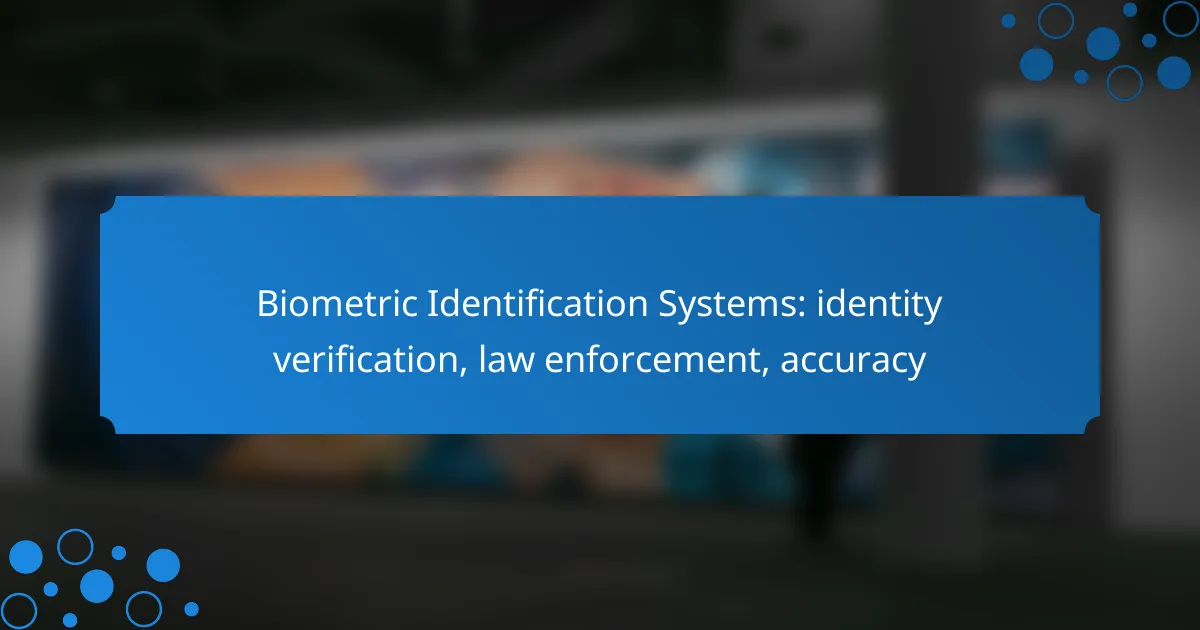Biometric identification systems play a crucial role in identity verification, particularly within law enforcement. Utilizing unique biological traits such as fingerprints and facial recognition, these technologies enhance the accuracy and efficiency of the identification process. Factors like data quality and environmental conditions significantly influence their reliability, making it essential to understand these elements for optimal implementation.
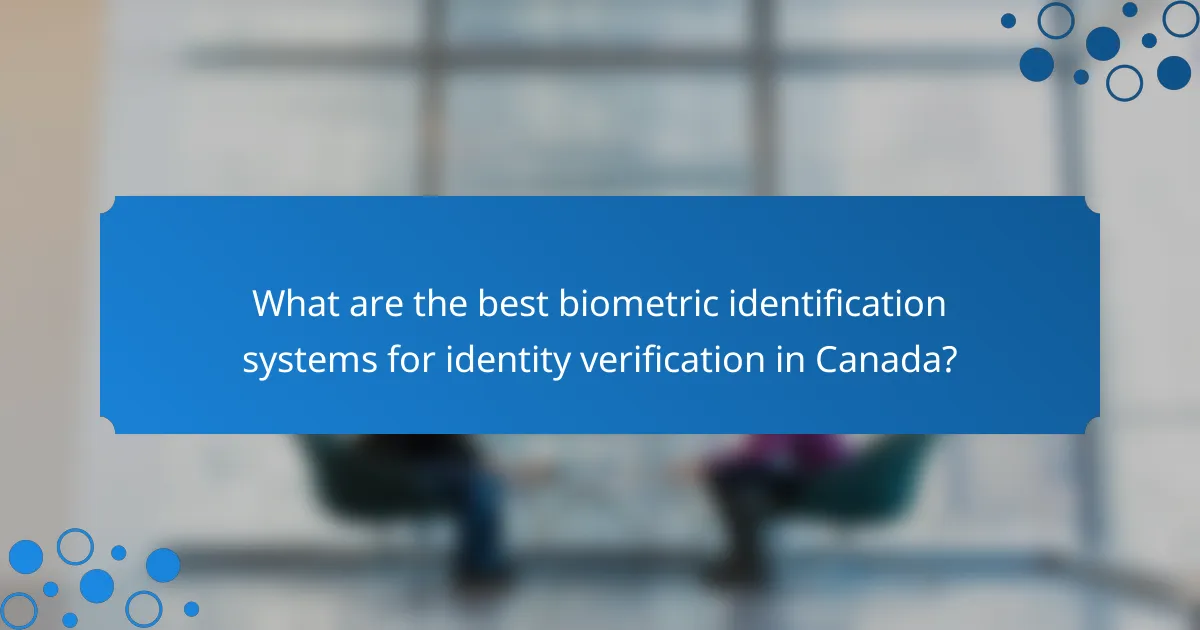
What are the best biometric identification systems for identity verification in Canada?
The best biometric identification systems for identity verification in Canada include face recognition, fingerprint scanning, retina scanning, voice recognition, and behavioral biometrics. These technologies vary in accuracy, implementation complexity, and user acceptance, making them suitable for different applications in security and law enforcement.
Face recognition systems
Face recognition systems analyze facial features to verify identity. They capture images and compare them against a database, often using algorithms to identify unique facial landmarks. In Canada, these systems are increasingly used in security settings, such as airports and public events, but concerns about privacy and accuracy remain.
When implementing face recognition, consider factors like lighting conditions and the angle of the face, as these can significantly affect accuracy. Additionally, ensure compliance with Canadian privacy laws, such as the Personal Information Protection and Electronic Documents Act (PIPEDA).
Fingerprint scanning technology
Fingerprint scanning technology captures the unique patterns of ridges and valleys on a person’s fingertips for identity verification. This method is widely used in various sectors, including law enforcement and access control, due to its high accuracy and reliability.
Fingerprint scanners can be optical, capacitive, or ultrasonic, each with its advantages. Optical scanners are common in consumer devices, while capacitive scanners offer better security. Ensure that the system you choose can handle a high volume of users efficiently, especially in busy environments.
Retina scanning solutions
Retina scanning solutions involve capturing the unique pattern of blood vessels in the retina for identification. This method is highly accurate and difficult to forge, making it suitable for high-security applications, such as government facilities and financial institutions.
While retina scanning offers excellent accuracy, it may not be as user-friendly as other methods, as it requires users to look directly into a scanning device. Consider user comfort and the potential need for specialized equipment when implementing this technology.
Voice recognition systems
Voice recognition systems analyze vocal characteristics to verify identity. These systems can be used for phone-based authentication or in-person verification, providing a convenient option for users. Voice recognition is increasingly integrated into customer service applications and smart devices.
Accuracy can be affected by background noise and the speaker’s emotional state, so it’s essential to test the system in various environments. Additionally, ensure that voice data is securely stored and processed to comply with privacy regulations in Canada.
Behavioral biometrics
Behavioral biometrics analyze patterns in user behavior, such as typing speed and mouse movements, to verify identity. This technology offers a continuous authentication method, monitoring users during their interactions with systems to detect anomalies.
Behavioral biometrics can complement other biometric systems, providing an additional layer of security. However, it may require significant data collection and analysis, so ensure that you have the necessary infrastructure and privacy measures in place to protect user information.

How do biometric identification systems enhance law enforcement in Canada?
Biometric identification systems significantly improve law enforcement in Canada by providing accurate and efficient methods for verifying identities. These systems utilize unique biological traits, such as fingerprints and facial recognition, to enhance the identification process, leading to faster and more reliable outcomes in criminal investigations.
Improved suspect identification
Biometric systems allow law enforcement to quickly and accurately identify suspects using unique biological markers. For instance, fingerprint analysis can match prints found at crime scenes to known offenders in seconds, reducing the time needed for investigations. This capability not only speeds up the identification process but also increases the likelihood of apprehending the correct individuals.
Additionally, facial recognition technology can scan images from surveillance footage and compare them against databases of known criminals. This method is particularly useful in urban areas where surveillance cameras are prevalent, enabling officers to identify suspects in real-time.
Real-time data access
With biometric identification systems, law enforcement agencies can access critical data in real-time, enhancing their operational efficiency. Officers in the field can use mobile devices to scan fingerprints or take photos for immediate identification checks, allowing for quicker decision-making during encounters.
This immediate access to biometric data can be crucial during high-stakes situations, such as traffic stops or public events, where identifying a suspect quickly can prevent further criminal activity. The integration of biometric systems into mobile applications ensures that officers have the latest information at their fingertips.
Integration with existing databases
Biometric identification systems can seamlessly integrate with existing law enforcement databases, such as criminal records and missing persons lists. This integration allows for a comprehensive approach to identity verification, as officers can cross-reference biometric data with multiple sources in a single query.
For example, if a suspect’s fingerprint is scanned, the system can simultaneously check against various databases to provide a complete profile, including any outstanding warrants or prior offenses. This holistic view aids in making informed decisions during investigations and arrests.
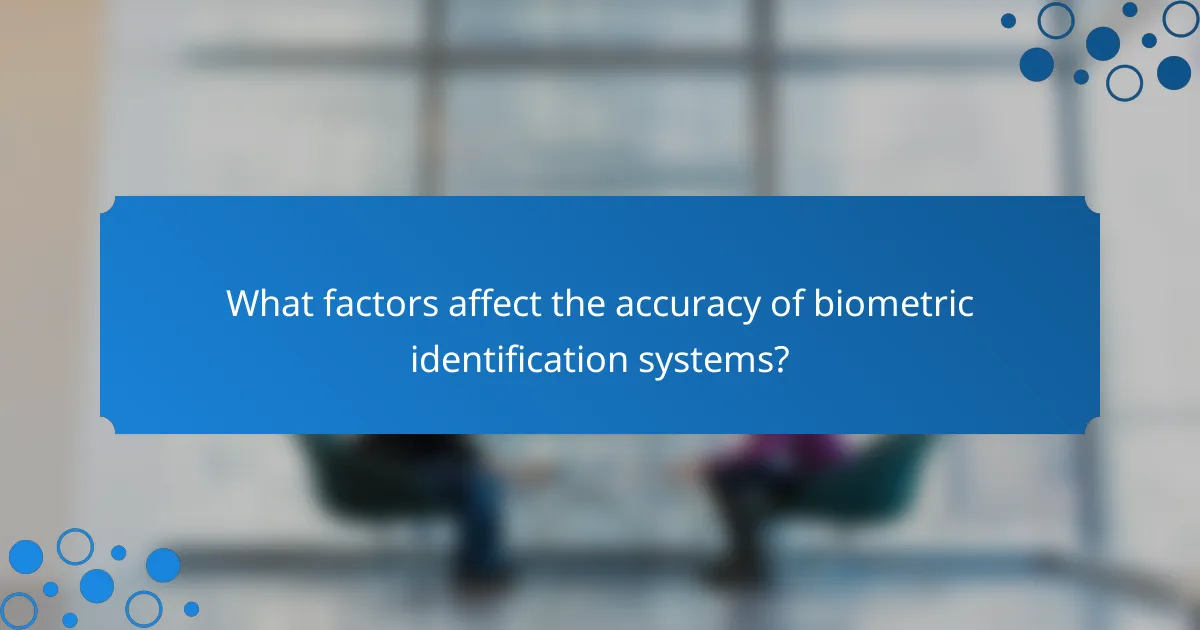
What factors affect the accuracy of biometric identification systems?
The accuracy of biometric identification systems is influenced by several key factors, including the quality of the biometric data collected, the environmental conditions during data capture, and the efficiency of the algorithms used for processing. Understanding these factors can help improve the reliability of biometric systems in various applications.
Quality of biometric data
The quality of biometric data is crucial for accurate identification. High-resolution images or samples, such as fingerprints or facial scans, lead to better recognition rates. Conversely, low-quality data, caused by poor lighting or smudged fingerprints, can significantly reduce accuracy.
To ensure high-quality data, it’s essential to use proper equipment and techniques during data collection. Regular maintenance of biometric devices and training for personnel can help minimize errors and improve the overall quality of the data captured.
Environmental conditions
Environmental conditions play a significant role in the performance of biometric systems. Factors such as lighting, temperature, and humidity can affect the capture and processing of biometric data. For instance, bright sunlight can create glare on facial recognition systems, while extreme temperatures may impact fingerprint scanners.
To mitigate these issues, biometric systems should be designed to operate effectively in various environments. This may include using adaptive algorithms that can adjust to changing conditions or implementing protective measures for devices used outdoors.
Algorithm efficiency
The efficiency of the algorithms used in biometric identification systems directly impacts their accuracy and speed. Advanced algorithms can process data more quickly and accurately, reducing the likelihood of false positives or negatives. It’s essential to choose algorithms that are well-suited for the specific type of biometric data being analyzed.
Regular updates and improvements to algorithms can enhance system performance. Organizations should stay informed about the latest advancements in biometric technology and consider upgrading their systems to incorporate more efficient algorithms as they become available.
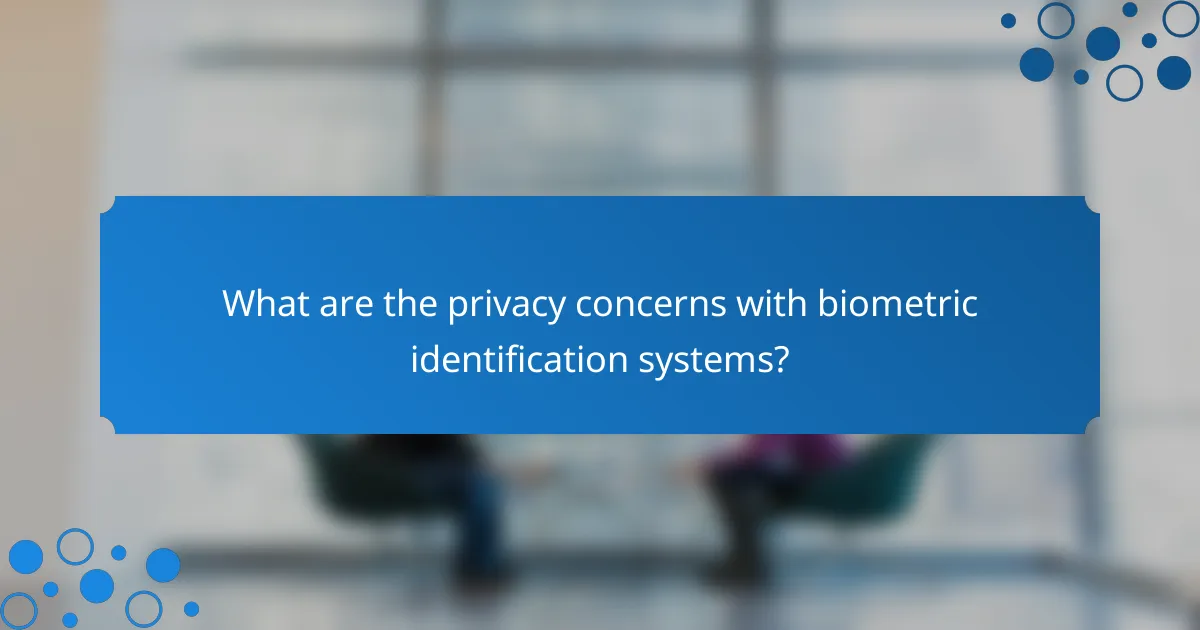
What are the privacy concerns with biometric identification systems?
Biometric identification systems raise significant privacy concerns primarily related to data security, consent, and the potential for misuse. As these systems collect and store sensitive personal information, the implications for individual privacy and rights are substantial.
Data security risks
Biometric data, such as fingerprints or facial recognition, is highly sensitive and can be targeted by cybercriminals. Unlike passwords, biometric traits cannot be changed if compromised, making the security of this data critical. Organizations must implement robust encryption and access controls to protect against unauthorized access.
Additionally, data breaches involving biometric information can lead to identity theft and fraud, with long-lasting effects on individuals. Regular security audits and compliance with standards like GDPR can help mitigate these risks.
Consent and user rights
Obtaining informed consent is essential when collecting biometric data. Users should be fully aware of how their information will be used, stored, and shared. Clear privacy policies and opt-in mechanisms can empower users to make informed decisions about their participation.
Moreover, individuals should have the right to access, correct, or delete their biometric data. Regulations in various regions, such as the GDPR in Europe, emphasize the importance of user rights in data protection, which organizations must adhere to.
Potential for misuse
Biometric identification systems can be misused for surveillance or discrimination, raising ethical concerns. For instance, law enforcement agencies may use these systems to monitor individuals without their consent, infringing on personal freedoms.
Moreover, biased algorithms can lead to unequal treatment of certain demographic groups, exacerbating social inequalities. Organizations should regularly assess their systems for bias and ensure transparency in their use to prevent such misuse.
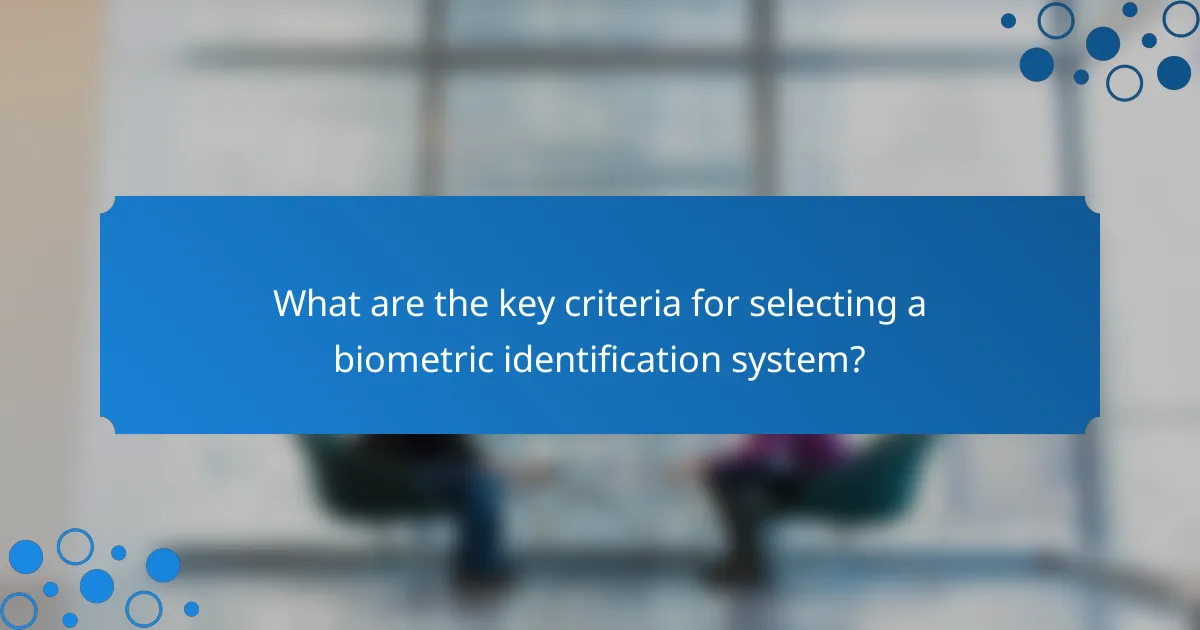
What are the key criteria for selecting a biometric identification system?
When selecting a biometric identification system, key criteria include integration capabilities and scalability. These factors ensure that the system can effectively work within existing infrastructures and adapt to growing user needs.
Integration capabilities
Integration capabilities refer to how well a biometric identification system can connect with other technologies and platforms. A system that easily integrates with existing security systems, databases, and software applications will streamline operations and enhance overall efficiency.
Consider systems that support common protocols and standards, such as ISO/IEC 19794 for biometric data interchange. This compatibility can significantly reduce implementation time and costs, allowing for smoother transitions and better user experiences.
Scalability of the solution
Scalability is the ability of a biometric identification system to grow and adapt as user demands increase. A scalable solution can handle an expanding number of users, devices, and data without compromising performance or accuracy.
When evaluating scalability, look for systems that can accommodate a wide range of biometric modalities, such as fingerprint, facial recognition, and iris scanning. Additionally, consider cloud-based solutions that can easily scale resources up or down based on current needs, which can be particularly cost-effective in dynamic environments.
